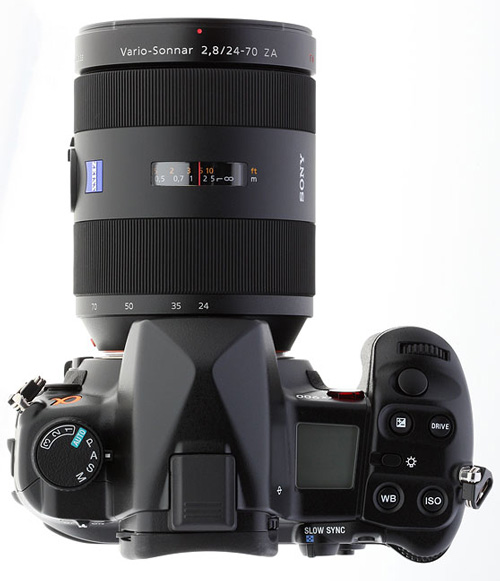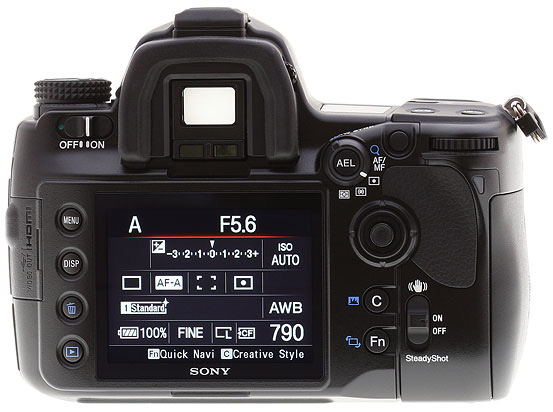Sony A900 Full-Frame: Hands-On Preview
by Wesley Fink on September 12, 2008 12:00 AM EST- Posted in
- Digital Camera
A900 Press Release
SAN DIEGO, Sept. 9, 2008
SONY UNVEILS FIRST FULL-FRAME ALPHA DSLR MODEL
Sony is introducing its full-frame α (alpha) DSLR-A900 camera, aimed at serious photo enthusiasts looking for traditional SLR performance with the added benefits of digital photography.

It is designed to deliver ultra-fine picture quality with the world's highest resolution, 24.6MP, 35mm full-frame CMOS sensor, and fast image processing with a new dual BIONZ processing engines. The camera is also the first to have a body-integrated image stabilization system for a full-frame sensor with Sony's SteadyShot Inside anti-shake system.
One look at the camera's distinctive pentaprism and nostalgic body design will evoke its full-frame optical performance. It features a bright, clear optical viewfinder with 100% field of view coverage that would impress even film photography loyalists.
"The α (alpha) DSLR-A900 introduction solidifies Sony's position as a leading camera manufacturer that can meet the demands of serious enthusiasts," said Phil Lubell, director of digital camera marketing at Sony Electronics. "It represents the best in sensor and image processing technologies and offers enhanced functions, performance, and reliability so photographers can push their creativity to the limit."
Ultra-Fine Images As the Human Eye Perceives Them
The camera's Exmor CMOS sensor delivers the photographic expressive power of wide angles and perspective that only a 35mm full-frame sensor can offer, and is designed to take advantage of the resolving power of high-precision α (alpha) lenses. Its high pixel count and large size provide enhanced image detail and a wider dynamic range for natural color reproduction and subtle tonal gradations.
The sensor is produced using proprietary Sony planarization technologies to ensure an ultra-flat surface across the entire imaging area. Instead of a single analog/digital convertor, the sensor uses over 6,000 on-chip, column-parallel A/D converters to convert analog signals to noise-resistant digital signals at the earliest possible stage. The result is reduced noise and high-speed transfer of data.
Image processing gets a boost in speed and power from the application of two BIONZ image processing engines. Large amounts of data captured by the 24.6MP sensor can be quickly processed to achieve a fast shooting response. Additionally, this dual BIONZ processing system applies advanced noise reduction algorithms producing images of exceptional quality and detail, especially at high ISO sensitivities.
World's First Anti-Shake System for a Full-Frame Sensor
The camera's newly developed, body-integrated SteadyShot Inside unit achieves an anti-shake effect equivalent to shutter speeds faster by 2.5 to 4 stops. This new unit provides stabilization for Sony, Minolta and Konica-Minolta wide-angle, large-aperture lenses, which is difficult for lens-integrated systems.
State-of-the-Art Optical Performance and Responsiveness
The ultra-bright viewfinder with 100% field of view coverage and 0.74x magnification enables accurate framing and preview. It features a high-power condenser lens, an eyepiece with high reflective-index glass, and a multi-layer, anti-reflective coating on every optical surface to deliver its extraordinarily bright and accurate view. Additionally, the focusing screen is user-replaceable, with additional L-type (grid pattern) and M-type (super spherical acute matte) screens sold separately.
The camera's newly developed autofocus system consists of nine wide-area sensors with 10 assist points for improved tracking of moving subjects. A center dual cross sensor comprised of two horizontal and two vertical line sensors as well as a dedicated f/2.8 sensor are included to achieve greater precision, especially when using fast-aperture lenses.
It also offers high-speed continuous shooting of 24.6MP images at five frames per second. A newly designed mirror box features a unique parallel-link mirror mechanism that moves on two horizontal axes to accommodate both 100% viewfinder coverage and the body-integrated image stabilization system without increasing the camera's size. The mirror box also has a new moving magnet actuator, a high-powered coreless motor for a faster shutter charge, and a magnet catcher to minimize mirror bounce and light refraction within the box.
Versatility to Unleash Creative Possibilities
The model's innovative intelligent preview function takes the guesswork out of setting up a shot and the hassle of taking multiple shots to achieve a desired effect.

After pressing the depth of field preview button, the camera "grabs" a RAW preview image, which is processed and displayed on the LCD screen. You can then fine tune white balance, determine the best level and effect of dynamic range optimization, adjust exposure compensation, and check histogram data, all before you actually take the picture. Preview images are not recorded on the camera's memory card, thus saving capacity.
Other key features aimed to expand creative options include the Dynamic Range Optimizer (DRO) with five levels of user-selectable correction as well as DRO bracketing for enhanced scene analysis and graduation optimization. EV bracketing with ±2EV range makes it easy to create high dynamic range composite images.
Thirteen creative styles can be selected to enhance images and then fine-tuned by customizing contrast, sharpness, zone matching and other parameters, while three user-programmable memories provide instant access to as many as 26 different mode settings.
Powerful RAW file processing control is put in the photographer's hands with the included Image Data Converter SR3 software that delivers faster file processing speeds, easy adjustment of image parameters, Dynamic Range Optimization, and a new Peripheral Illumination function that compensates for corner light fall off.
With the camera's HDMI output and Photo TV HD mode, your creative output can be enjoyed on a compatible HD television. This mode brings the look of actual printed photography to the television, by fine-tuning such image parameters as sharpness, gradation, and color.
Comfort in Your Hands
Its construction features rugged, lightweight magnesium alloy with moisture-resistant, rubber seals for buttons and dials, an anti-static coating to prevent dust adherence to the imager, and a high-endurance shutter rated for more than 100,000 release cycles.
It has a 3-inch, Xtra Fine LCD screen (921K) that makes it possible to check focus and image quality with accuracy. It incorporates an easy-to-see display with a quick navigation menu to easily access common functions without interrupting your creative flow. A backlit LCD panel sits on top of the camera and displays key settings.
System Expansion with New Accessories

The A900 camera will be accompanied with an array of accessories like the recently-announced Sony HVL-F58AM flash unit with its innovative Quick Shift Bounce system, powerful performance with a guide number of 58, and wireless auto flash ratio control.

The Sony VG-C90AM vertical grip offers the same ease of operation when shooting vertically as horizontally, with its button layout and low-position shutter-release button. It also houses two InfoLITHIUM batteries (sold separately) for longer shooting and playback.
The DSLR-A900 body will be available in November for about $3,000 along with related accessories. All will be available at authorized dealers, at military base exchanges, Sony Style retail stores, and at sonystyle.com. Online pre-orders began on Sept. 10.










53 Comments
View All Comments
Wesley Fink - Friday, September 12, 2008 - link
That is the EN-EL4(a) battery for the Nikon Pro cameras and the Sony capacity is specified as 1650mAh and not 16500. We do need an edit function here!dr4gon - Friday, September 12, 2008 - link
The memory stick is so that you have the ability to shoot RAW+JPG. It's just for redundancy in case your compact flash card dies for whatever reason. All is not lost since the JPEGs can be saved on the MS like the a700.VirtualMirage - Friday, September 12, 2008 - link
On the a700 you can only shoot to one memory card or the other at any given time. When set to RAW+JPEG, it doesn't send one file to one card and the other file to the other card (that option is not even available). It would be neat if it did, though, since I could have used that feature with my a700 when doing a wedding shoot back in June. The camera also doesn't automatically switch over to the other card when the first card is full, you have to go into the menu and switch it over manually. The a900, from reading a preview on another site, does the exact same thing in regards to memory card management as the a700 (which is a bit of a shame).As for the use of a memory stick and CF, I can understand the con with this since if you want to have a fall back memory card you have to deal with two different memory card formats. But the advantage to it, though, is a smaller camera profile since two CF card slots would require a little more room.
Below are some features I wish my a700 did (as well as the new a900) in regards to its two memory card slots:
-Automatic switchover when the first card is full.
-Option to have RAW files go to one card and a JPEG version go to the other card.
-Backup mode where ever picture shot is copied (in the same file format) to both cards.
Shame they don't do this. But oh well, the a700 is still a great camera. And with the new firmware that got leaked out earlier this week (v.4), it's an even better camera since they added some features to the a700 that are in the a900. Some of these improvements are: High ISO NR can now be turned off (used to be you can go no further than LOW), Image quality algorithms have been improved with NR on and off (finer grain pattern in high ISO shots, no more watercolor NR), EV bracketing now has a +/- 2 option for HDR shooting, and some people are reporting WB has improved in certain lighting. Their maybe more improvements, but since it was leaked with no update readme (and was quickly removed from the site too when it was discovered), the only improvements mentioned are what people have found after installing it. Supposedly, the official release of the firmware update is sometime next week (the 16th is what I am hearing). Probably so as to not steal the a900's thunder.
~Paul